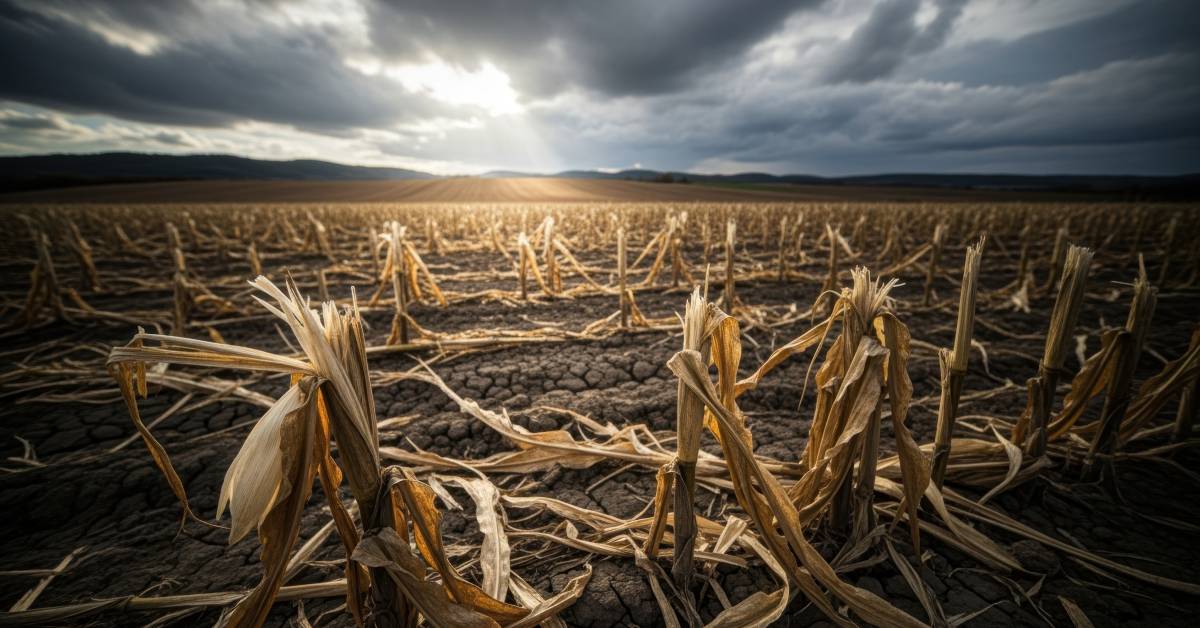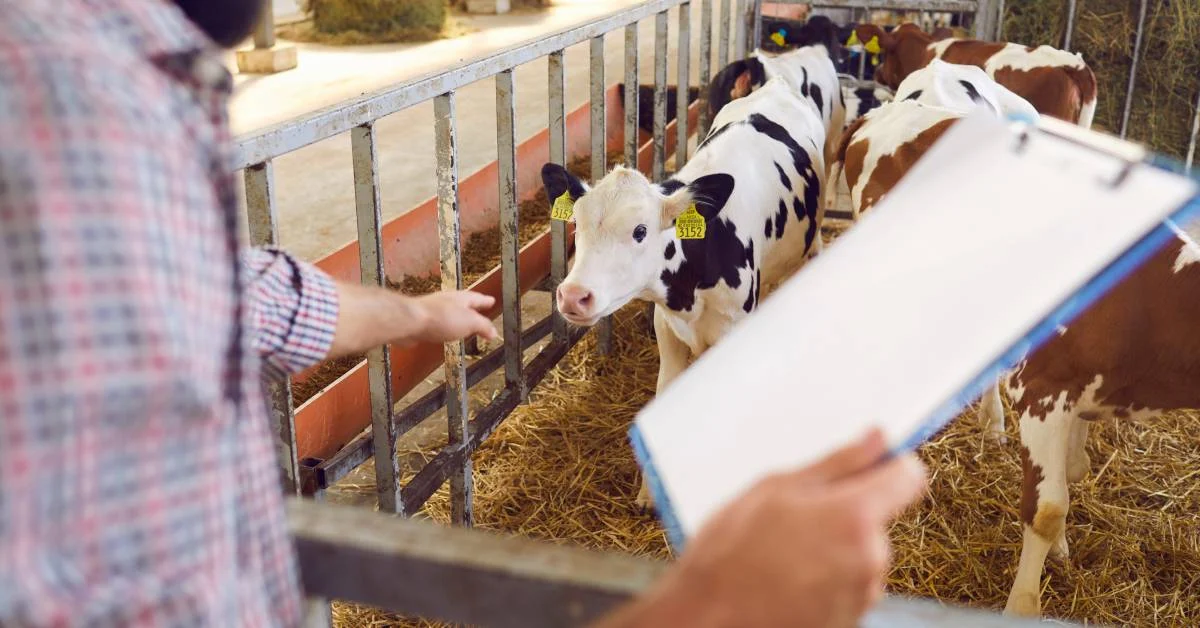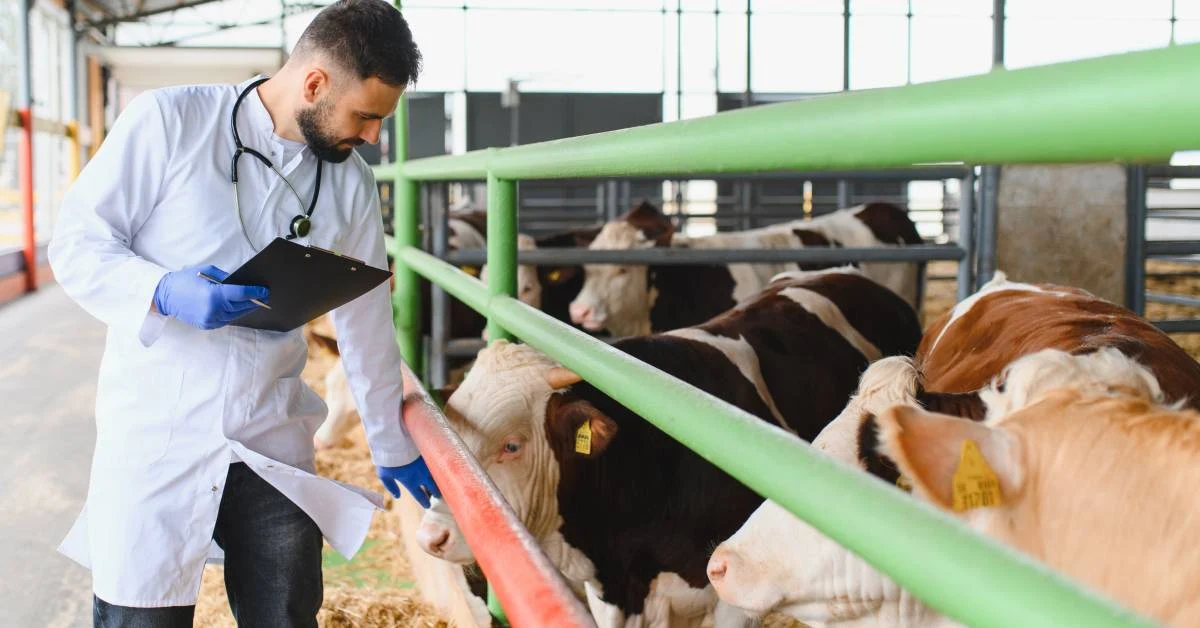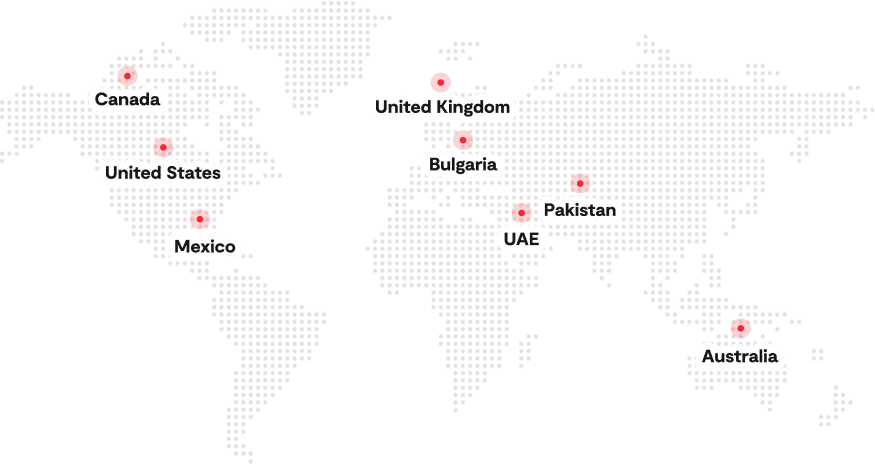Crop failure is one of the most pressing challenges facing farmers, agricultural professionals, and policymakers today. When a growing season ends with poor or failed yields, the effects ripple far beyond the farm. Families and rural communities face income losses, food supplies tighten, and market prices fluctuate, creating widespread economic stress. An environmental research letter at IOPSciences states that by 2030, the chances of major crop yield failures in key farming regions are expected to double, and by 2050, synchronized failures of staple crops like wheat, rice, maize, and soy could occur once every 11 years.
Crop failures rarely result from a single factor. Instead, they are often caused by a combination of unpredictable weather, pest infestations, poor soil health, or management issues. In today’s world of climate change and rising global food demand, the stakes are higher than ever, and preparation is key.
In this blog, we will explore the top causes of crop failure, their economic and environmental consequences, and practical strategies farmers can use to protect their crops and reduce risks. Whether you are managing a small farm, running a large-scale operation, or working in agricultural policy, this guide will help you understand the threats to production and the proven methods to prevent them. By the end, you’ll have actionable insights to strengthen resilience and secure a more stable growing season with the right technology and analysis.
Common Causes of Crop Failure
Crop failure can result from a combination of environmental, biological, and human factors. Understanding the causes is essential for farmers and ag professionals to protect yields, minimize losses, and lead towards sustainable crop production. From unpredictable weather to pest infestations, inadequate farming practices, and broader socioeconomic pressures, each factor can significantly reduce crop productivity and farm profitability. Identifying and addressing these causes allows farmers to implement better risk management strategies, adopt sustainable agriculture practices, and safeguard their harvests against recurring losses.
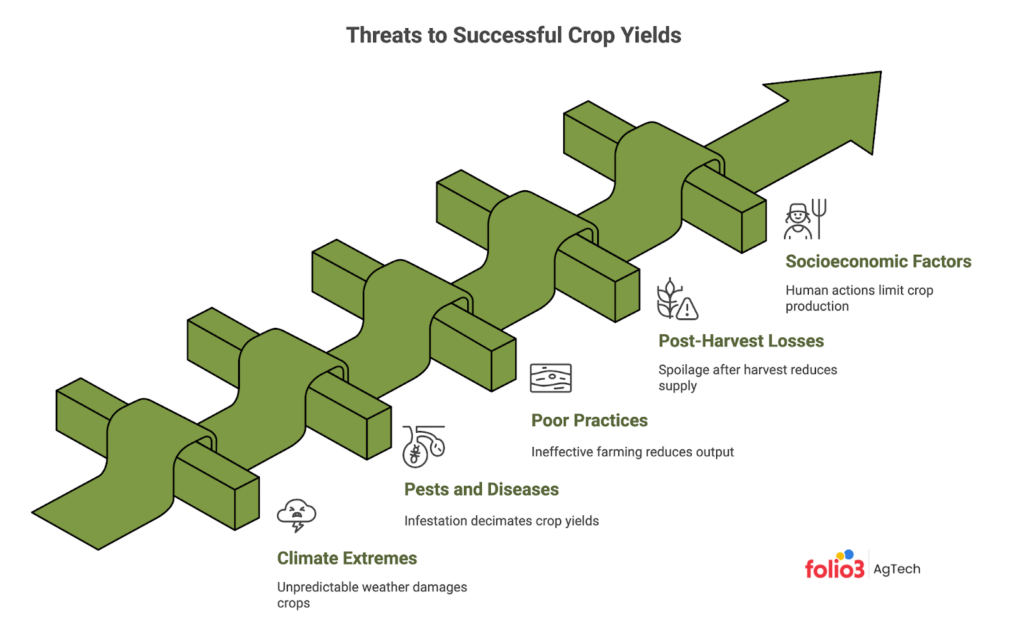
Climate and Weather Extremes
One of the leading causes of crop failure is extreme weather. Heat waves can stress crops, reducing photosynthesis and stunting growth, while prolonged droughts limit water availability, causing wilting and reduced yields. On the other hand, unexpected frost events can damage sensitive plants, especially during flowering and early growth stages. Flooding is another major risk, as excess water suffocates roots, promotes disease, and can completely destroy fields in low-lying areas. Climate change is making these events more frequent and unpredictable, forcing farmers to adapt climate smart agriculture practices quickly.
Variations in rainfall patterns can disrupt planting schedules and reduce soil fertility. Beyond physical damage, extreme weather also affects the timing of harvests, complicating logistics and increasing post-harvest losses. Farmers increasingly rely on crop insurance, weather forecasts, and resilient crop varieties to mitigate these risks and improve soil fertility before it’s too late. Integrating modern irrigation systems, soil conservation, and timely intervention can help minimize the impact of climate extremes, but the rising intensity of heat waves, droughts, floods, and frost events continues to challenge farm productivity worldwide.
Pests, Diseases, and Weeds
Pest control for crops is critical for preventing significant economic losses. Insects, fungi, bacteria, and viruses can rapidly spread through fields, destroying crops and reducing yields. Weeds compete for nutrients, sunlight, and water, further stressing plants. Climate change has amplified these risks by creating favorable conditions for pests and diseases to thrive longer and in new regions. The financial burden of controlling infestations can be substantial, often requiring costly chemicals, labor, and monitoring systems.
Failure to manage these threats effectively can wipe out entire harvests. Integrated pest management strategies, including crop rotation, biological controls, and timely pesticide application, are essential for protecting crops while minimizing environmental impact. Farmers who ignore early warning signs or fail to invest in prevention often face the harshest losses, emphasizing the need for proactive pest management to maintain both productivity and profitability.
Poor Agronomic Practices
Unsustainable farming practices contribute heavily to crop failure. Using low-quality seeds or planting crops unsuited to the soil and climate reduces yield potential. Monocropping depletes soil nutrients and increases vulnerability to pests and diseases. Poor soil management, such as inadequate fertilization or neglecting soil health, limits plant growth and resilience. Neglecting essential practices like pest control, irrigation planning, and crop rotation further weakens the farm’s productivity. Sustainable farming practices, including diverse crop selection, proper fertilization, and soil conservation, help mitigate these risks and improve long-term farm resilience. Farmers who invest in these practices are better equipped to withstand environmental and biological challenges.
Post-Harvest and Infrastructure Losses
Post-harvest losses remain a significant obstacle for many farmers. Improper storage conditions, transportation delays, and inadequate packaging lead to spoilage and reduced marketable yield. Even high-quality crops can lose value if infrastructure fails to support timely distribution. Using digital harvest logs helps track produce quality and timing. At the same time, investment in better storage facilities and cold chain in agriculture is essential to reduce post-harvest losses and protect income.
Broader Human and Socioeconomic Factors
Farm risk management extends beyond environmental and biological threats. Conflict, poor planning, limited access to credit, and policy failures can all contribute to crop failure. Without investment in infrastructure, education, and advisory services, farmers struggle to adopt modern techniques and adapt to changing conditions. Addressing these socioeconomic factors is critical to creating resilient agricultural systems and ensuring stable food production.
Consequences of Crop Failure
Crop failure affects more than just the fields where crops are grown. Its impact ripples through farmers’ livelihoods, local economies, and even national and global food systems. Understanding these consequences is essential for farmers, ag professionals, and policymakers to make informed decisions about farm risk management, investment in resilient practices, and strategies to protect both income and food security. By recognizing the breadth of these effects, stakeholders can take steps to reduce vulnerability and strengthen the stability of agricultural systems.
Impact on Farmers
For individual farmers, crop failure directly translates to loss of income and financial insecurity. Smallholders are especially vulnerable, as they may lack savings or access to insurance. Failed harvests can make it difficult to repay loans, cover household expenses, or invest in the next planting season, creating a cycle of vulnerability that is hard to break.
Effects on Rural Economies
Agriculture is the backbone of many rural communities. When crops fail, employment opportunities decline, local markets shrink, and businesses dependent on farm produce, such as suppliers, transporters, and processors, also suffer. The economic strain spreads through the community, affecting livelihoods beyond the farm itself and sometimes triggering social challenges like migration or reduced educational opportunities.
Rising Food Prices
Crop failure increases scarcity in local and national food markets. Staple crops like wheat, maize, rice, and soy become more expensive, putting pressure on households, particularly low-income families. Price spikes reduce food affordability, worsen malnutrition, and can create unrest in regions that rely heavily on agricultural output for daily sustenance.
Threats to Global Food Security
When major breadbasket regions experience repeated or synchronized crop failures, the global food supply is disrupted. This can lead to shortages, trade imbalances, and emergency aid requirements. Rising demand combined with declining supply threatens long-term food security, making resilient farming practices and proactive farm risk management essential to prevent crises.
Understanding these consequences highlights the urgent need for solutions that protect farmers, stabilize rural economies, and safeguard both national and global food systems against the cascading effects of crop failure.
Illustrated Case Studies & Global Data
Examining real-world examples helps illustrate the scale and impact of crop failures. These case studies highlight how environmental and biological factors can devastate harvests and threaten food security.
Extreme Weather Events in the United States (2023)
In 2023, the United States experienced severe weather events, including droughts and floods, leading to over $21 billion in crop and rangeland losses. These conditions affected a variety of crops, including grains and oilseeds, with the Midwest and Great Plains being particularly hard-hit. (Source)
Desert Locust Outbreak in Afghanistan (2023)
Afghanistan faced a significant desert locust outbreak in 2023, threatening up to 25% of its annual wheat production. The infestation exacerbated the country’s food insecurity, already strained by ongoing conflicts and economic challenges. (Source)
These real-world examples show that crop failures are not just theoretical; they have tangible impacts on farmers and food systems worldwide. Understanding these challenges sets the stage for exploring effective strategies for crop failure prevention.
Methods to Prevent or Mitigate Crop Failure
Preventing crop failure requires a combination of smart farming practices, technology adoption, and proactive planning. Farmers who integrate multiple strategies can reduce risks, safeguard yields, and improve farm resilience.
Integrated Pest Management
Effective pest control is crucial to prevent crop failure. Integrated pest management (IPM) combines biological controls, crop rotation, and targeted pesticide use to minimize damage from insects, diseases, and weeds. Regular field monitoring and early intervention help detect threats before they escalate, protecting crops and reducing financial losses.
Better Seed Selection
Choosing the right seeds is a simple yet powerful way to prevent crop failure. Farmers should select high-quality, locally adapted, and climate-resilient varieties. These seeds are more resistant to extreme weather, pests, and diseases, ensuring better germination, growth, and ultimately, higher yields.
Soil Health Management
Maintaining healthy soil is essential for preventing crop failure. Practices such as cover cropping, compost addition, and balanced fertilization improve soil structure, water retention, and nutrient availability. Healthy soils enhance crop resilience to droughts, floods, and nutrient stress, reducing the likelihood of losses.
Technology Adoption
Modern technologies provide farmers with real-time insights to prevent crop failure. Sensors monitor soil moisture and nutrient levels, drones detect early signs of pest infestations, and satellite mapping identifies vulnerable areas in fields. These tools allow timely interventions, better resource allocation, and improved decision-making.
Planning and Farm Management
Proactive planning supports crop failure prevention. Diversifying crops, scheduling plantings based on weather forecasts, and maintaining contingency plans for irrigation or pest outbreaks help minimize risk. Combining traditional knowledge with data-driven strategies ensures farms are better prepared for unpredictable conditions.
By implementing these methods, farmers can significantly reduce the risk of crop failure, protect their livelihoods, and contribute to more stable food systems. A strategic approach that blends sustainable practices with modern technology is the key to long-term resilience.
Climate Risk and Crop Insurance
Climate variability poses a growing threat to farm productivity and farmer livelihoods. Crop insurance helps manage these risks by providing financial protection against losses from extreme weather and other climate-related events.
Benefits of Crop Insurance
Climate variability is a leading cause of crop failure. Droughts, floods, heat waves, and unexpected frosts can destroy entire harvests, leaving farmers financially vulnerable. Crop insurance provides a safety net by compensating for damaged or lost crops. This support helps farmers recover quickly, maintain cash flow, and continue operations even after severe weather events. Insurance also encourages investment in resilient farming practices, such as improved irrigation, better seed selection, and soil management techniques.
Limitations of Crop Insurance
While crop insurance is essential, it has limitations. Policies may not cover all types of losses or adequately compensate for extreme or widespread events. In many developing regions, smallholder farmers lack access to affordable insurance, leaving them exposed to repeated crop failures. The claims process can also be slow and complex, reducing its effectiveness during urgent situations.
Future Adaptation Needs
To strengthen resilience, crop insurance must be complemented by climate adaptation strategies. Early warning systems, climate-resilient crop varieties, and sustainable agronomic practices are critical to reducing vulnerability. Expanding coverage, streamlining claims, and improving farmer awareness ensure that insurance works effectively as part of a broader risk management strategy.
Role of Technology
Technology can enhance crop insurance effectiveness and overall risk management. Tools such as soil sensors, drones, satellite mapping, and predictive analytics allow farmers to monitor crop health, detect early stress signs, and take preventive action. Integrating these technologies with insurance programs helps reduce losses, optimize interventions, and build more resilient farms. This naturally leads to solutions like Folio3 Agtech’s crop management software, which minimizes crop failure risks through real-time insights and actionable data.
How Folio3 Agtech Helps Farmers Prevent Crop Failures
Folio3 Agtech’s crop management software is built to help farmers take control of their fields and protect their harvests. By combining real-time data, predictive insights, and easy-to-use tools, it empowers farmers to anticipate potential problems, reduce risks, and make informed decisions throughout the growing season. This software is designed for farmers and ag professionals who want to optimize yields while minimizing the threats of pests, diseases, extreme weather, and other factors that can lead to crop failure.
Key Features
- Real-Time Crop Monitoring
- Pest and Disease Alerts
- Weather and Climate Insights
- Yield Forecasting
- Field Mapping and Analytics
- Reporting and Compliance
With these features, Folio3 Agtech gives farmers a clear picture of their fields and the information needed to act before problems escalate. Enabling proactive farm management helps reduce crop failure risks, improve productivity, and ensure more consistent yields. The combination of technology and actionable data allows farms to become more resilient to environmental challenges, safeguard their investments, and plan for sustainable growth in an unpredictable agricultural landscape.
Conclusion
Preventing crop failure requires a comprehensive approach that addresses environmental, biological, and socioeconomic risks. Farmers face challenges from extreme weather, pests and diseases, poor agronomic practices, and broader economic pressures, each of which can significantly reduce yields. Addressing these challenges effectively demands integrated solutions, combining sustainable farming practices, crop insurance, technology adoption, and proactive farm management.
Tools like real-time monitoring, predictive analytics, and crop management software enable farmers to make informed decisions and take timely action, reducing the likelihood of losses. By combining these strategies, farmers can enhance resilience, protect livelihoods, and contribute to stable food systems. Ultimately, preventing crop failure is not just about responding to individual threats; it is about building a multi-layered defense that safeguards crops, optimizes productivity, and ensures long-term sustainability in an increasingly unpredictable agricultural landscape.
FAQs
What Is Crop Failure?
Crop failure occurs when a planted crop does not reach its expected yield due to factors such as extreme weather, pests, diseases, poor agronomic practices, or socioeconomic challenges. It results in reduced productivity and financial losses for farmers.
Will There Be Crop Failure By 2030?
Rising climate shocks are expected to increase the risk of crop failures. By 2030, the likelihood of yield failures in major breadbasket regions is projected to double, highlighting the need for resilient farming practices and proactive risk management.
What Is Crop Failure Called?
Crop failure is also referred to as crop loss or harvest failure. It describes a situation where crops fail to produce the expected quantity or quality of produce. This can have significant economic impacts on farmers and affect local and global food supply chains.
Why Are Crops Failing?
Crops fail due to a combination of factors, including extreme weather, pest infestations, diseases, poor soil health, monocropping, lack of proper inputs, and broader socioeconomic issues such as conflict or insufficient investment in agriculture.
How To Solve Crop Failure?
Preventing crop failure requires integrated solutions such as using climate-resilient seeds, adopting sustainable farming practices, implementing pest management strategies, leveraging crop insurance, and utilizing technology like crop management software to monitor fields and make informed decisions.

